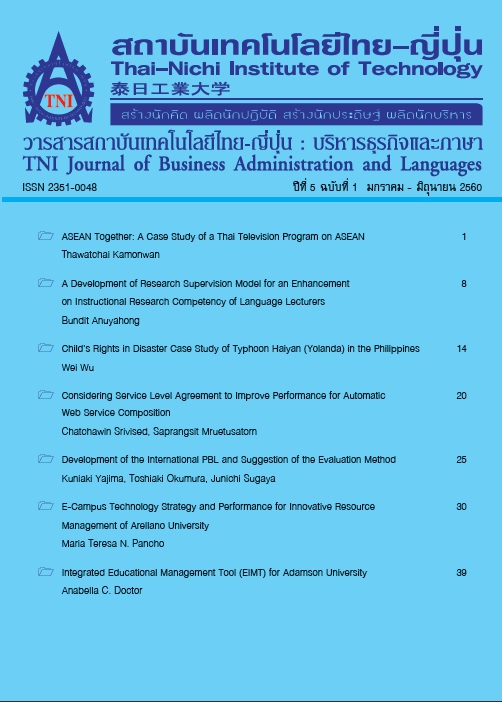Output Based upon Input, the Result from Data Analytics and Visualization of TNI Registration System’s Data
Main Article Content
Abstract
The large amount of computerized data in business has been steadily increasing over the years. Data extraction using data analytics and visualization have been widely used to discover information knowledge from various areas. This paper analysed data with statistic tools and visual analysis to extract and gather information from registration system in order to;
- 1. Understand students and predict an academic performance condition.
- 2. Compare a knowledge’s result from statistic tools with graphical output from visualization software.
Registration data was obtained from department of academic affair of Thai-Nichi Institute of Technology from year 2007-2015. In this study, we only focused on IT student’s data that contains 1,822 rows. Based on the applied techniques that we have developed, we found that academic performance (GPA) of TNI’s IT students have lower average GPAs and not different result from their previous level (High school). In addition, data analytic and visual analysis can help a university to evaluate their teaching performance, gain insight into their students, discover knowledge and make evidence-based for future educational planning decisions. Moreover, Data visualization allows an organization to make better business decisions from allows insights into a big data.
Article Details
Article Accepting Policy
The editorial board of Thai-Nichi Institute of Technology is pleased to receive articles from lecturers and experts in the fields of business administration, languages, engineering and technology written in Thai or English. The academic work submitted for publication must not be published in any other publication before and must not be under consideration of other journal submissions. Therefore, those interested in participating in the dissemination of work and knowledge can submit their article to the editorial board for further submission to the screening committee to consider publishing in the journal. The articles that can be published include solely research articles. Interested persons can prepare their articles by reviewing recommendations for article authors.
Copyright infringement is solely the responsibility of the author(s) of the article. Articles that have been published must be screened and reviewed for quality from qualified experts approved by the editorial board.
The text that appears within each article published in this research journal is a personal opinion of each author, nothing related to Thai-Nichi Institute of Technology, and other faculty members in the institution in any way. Responsibilities and accuracy for the content of each article are owned by each author. If there is any mistake, each author will be responsible for his/her own article(s).
The editorial board reserves the right not to bring any content, views or comments of articles in the Journal of Thai-Nichi Institute of Technology to publish before receiving permission from the authorized author(s) in writing. The published work is the copyright of the Journal of Thai-Nichi Institute of Technology.
References
I. Ognjanovic, D. Gasevic, and S. Dawson, “Using institutional data to predict student course selections in higher education,” Internet and Higher Education, vol. 29, pp. 49–62, 2016.
AnneMarie Scarisbrick‐Hauser, “Data analysis and profiling,” Direct Marketing: An Intl Jnl, vol. 1, no. 2, pp. 114–116, Jun. 2007.
C. Vialardi et al., “A Data Mining Approach to Guide Students Through the Enrollment Process Based on Academic Performance,” User Modeling and User-Adapted Interaction, vol. 21, no. 1–2, pp. 217–248, Apr. 2011.
Office of Higher Education Commission (HEC). (2016, Mar 1). University in Thailand [Online] Available: https://www.mua.go .th/university.html
National Statistical Office of Thailand. (2016, Mar 5). Thailand Population [Online] Available: www. nso.go.th
G. Kevin, H. Ray, and E. David, Strategic Information Systems Management, 1st ed. Andover: Cengage Learning EMEA, 2009.
R. Sherman, “Chapter 15 - Advanced Analytics,” in Business Intelligence Guidebook, R. Sherman, Ed. Boston: Morgan Kaufmann, 2015, pp. 375 – 402.
C. John P., D. Peter B., and O. Diana G., “Academic Analytics: A New Tool for a New Era,” EDUCAUSE Review, vol. 42, no. 4, p. 40, 2007.
A. O. Julian, Q. Sally, and K. Rachel, “Attachment style, social skills, and Facebook use amongst adults,” Computers in Human Behavior, vol. 29, no. 3, pp. 1142–1149, May 2013.
M. Michikyan, K. Subrahmanyam, and J. Dennis, “Facebook use and academic performance among college students: A mixed-methods study with a multi-ethnic sample,” Computers in Human Behavior, vol. 45, pp. 265–272, Apr. 2015.
S. Ainin, M. M. Naqshbandi, S. Moghavvemi, and N. I. Jaafar, “Facebook usage, socialization and academic performance,” Computers & Education, vol. 83, pp. 64 – 73, 2015.
K. Platts and K. H. Tan, “Strategy visualisation: knowing, understanding, and formulating,” Management Decision, vol. 42, no. 5, pp. 667–676, 2004.
C.-H. Kao, J. Nakano, S.-H. Shieh, Y.-J. Tien, H.-M. Wu, C. Yang, and C. Chen, “Exploratory data analysis of interval-valued symbolic data with matrix visualization,” Computational Statistics & Data Analysis, vol. 79, pp. 14 – 29, 2014.
R. Ashman and A. Patterson, “Seeing the big picture in services marketing research: infographics, SEM and data visualisation,” Journal of Services Marketing, vol. 29, no. 6/7, pp. 613–621, 2015.
V. L. Lemieux, B. Gormly, and L. Rowledge, “Meeting Big Data challenges with visual analytics: The role of records management,” Records Management Journal, vol. 24, no. 2, pp. 122–141, 2014.
A. A. Ganah, “The Use of Computer Visualisation Communica ting Constructability Information in UK,” Journal of Engineering, Design and Technology, vol. 1, no. 2, pp. 151–167, 2003.
B. Hirsch, A. Seubert, and M. Sohn, “Visualisation of data in management accounting reports: How supplementary graphs improve every-day management judgments,” Journal of Applied Accounting Research, vol. 16, no. 2, pp. 221–239, 2015.


